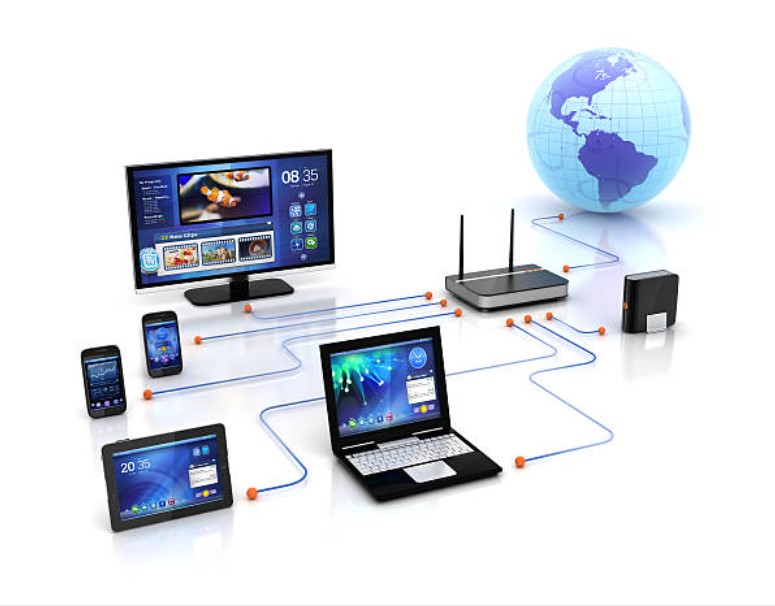Computer networking is the practice of connecting and interconnecting multiple computing devices, such as computers, servers, smartphones, and more, to facilitate communication, data sharing, and resource sharing. It enables these devices to exchange data, access the internet, and work together in various ways. Computer networking is a fundamental part of our modern, interconnected world, and it plays a crucial role in both residential and business environments.
Key aspects of computer networking include:
- Data Communication: Computer networks allow devices to send and receive data, which can include text, files, multimedia content, and more. This data communication can occur over wired or wireless connections.
- Internet Access: Networking enables devices to connect to the internet, providing access to a vast array of online resources, services, and information.
- Resource Sharing: Devices on a network can share resources such as printers, files, and even processing power. This resource sharing enhances efficiency and collaboration.
- Remote Access: Networking allows users to access resources and data from remote locations, which is particularly important in today’s globalized and remote-work-friendly world.
- Security: Computer networking includes security measures to protect data and systems from unauthorized access and cyber threats. This involves encryption, firewalls, access controls, and other security practices.
- Scalability: Networks can be designed to accommodate the addition of more devices as needed, making them scalable to meet changing requirements.
- Fault Tolerance: Many networks are designed with redundancy and failover mechanisms to ensure that if one part of the network fails, data and communication can continue via alternative paths.
Computer networking encompasses a wide range of technologies, including Ethernet, Wi-Fi, cellular networks, and more. It also involves the use of networking protocols (such as TCP/IP), hardware devices like routers and switches, and network infrastructure to ensure reliable and efficient communication.
In essence, computer networking is the backbone of our digital world, enabling devices to connect, communicate, and collaborate, whether it’s for accessing information on the web, sharing files within a local network, or facilitating global business operations.
Networking Essentials: Devices, LAN, WAN, Wi-Fi, and Mesh Networks
Devices:
- Devices in computer networking refer to the hardware components that are part of a network, such as computers, laptops, smartphones, tablets, servers, printers, switches, routers, and more.
- These devices can connect to a network to share data, resources, and communicate with each other.
Local Area Network (LAN):
- A Local Area Network (LAN) is a network that connects devices within a limited geographical area, such as a home, office building, or campus.
- LANs are typically used for local communication and resource sharing, including file sharing, printing, and internet access.
- Ethernet cables and Wi-Fi are common technologies used to create LANs.
Wide Area Network (WAN):
- A Wide Area Network (WAN) spans larger geographical areas, often connecting multiple LANs over long distances.
- WANs enable data transmission between distant locations and are used for global internet connectivity.
- The internet itself is the largest example of a WAN.
Wi-Fi (Wireless Fidelity):
- Wi-Fi is a wireless networking technology that allows devices to connect to a LAN or the internet without the need for physical cables.
- Wi-Fi networks use radio waves to transmit data between devices and a wireless access point (router).
- Wi-Fi is commonly used in homes, businesses, public places, and various devices like smartphones, laptops, and IoT devices.
Mesh Network:
- A mesh network is a type of network topology where each device (node) is connected to every other device, creating multiple paths for data to travel.
- Mesh networks are known for their redundancy and reliability. If one path fails, data can take an alternative route.
- They are often used in scenarios where coverage, reliability, and self-healing capabilities are crucial, such as smart home systems and outdoor wireless networks.
In summary, devices are the hardware components used in networking, LANs connect devices within a limited area, WANs connect larger geographical areas, Wi-Fi enables wireless connectivity, and mesh networks provide redundancy and reliability through interconnected nodes. These concepts are fundamental to understanding how networks function and how devices communicate and share data in various environments.
Network topologies
Network topology refers to the physical or logical layout or arrangement of devices, nodes, and connections in a computer network. It defines how these elements are interconnected and how data flows within the network. Network topology is a fundamental aspect of network design and influences various factors such as performance, scalability, and fault tolerance. There are several common network topologies, each with its own characteristics:
- Bus Topology:
- In a bus topology, all devices are connected to a single central cable, known as the “bus” or backbone.
- Data travels along the bus, and each device on the network receives all transmitted data.
- Devices use addresses to determine whether data is intended for them.
- Simple and cost-effective but can experience data collisions and is not very scalable.
- Ring Topology:
- In a ring topology, each device is connected to exactly two other devices, forming a closed loop or ring.
- Data circulates around the ring in one direction until it reaches its destination.
- Reliable and predictable but can be expensive to install and expand. A single break in the ring can disrupt the entire network.
- Star Topology:
- In a star topology, all devices are connected to a central hub or switch.
- Data travels through the central hub, which controls the flow of data to the intended device.
- Easy to install and manage, offers high reliability, and allows for easy addition of new devices.
- However, if the central hub fails, the entire network can be affected.
- Mesh Topology:
- In a mesh topology, every device is connected to every other device in the network.
- Provides redundancy and fault tolerance since multiple paths exist for data to travel.
- High reliability but can be expensive to implement due to the numerous connections required.
- Two main types: full mesh (every device connects to every other device) and partial mesh (only some devices have direct connections to others).
- Hybrid Topology:
- Combines two or more different topologies to form a more complex network.
- Allows for customization to meet specific network requirements.
- Common hybrid topologies include a combination of star and bus or star and ring topologies.
- Tree (Hierarchical) Topology:
- Hierarchical in structure, resembling a tree with a root and branches.
- Commonly used in large networks where multiple star or bus topologies are interconnected.
- Provides scalability and segmentation of the network but can be complex to manage.
- Point-to-Point Topology:
- Simplest topology with a direct connection between two devices.
- Often used for temporary connections, such as serial connections between routers.
The choice of network topology depends on factors like the network’s size, budget, scalability requirements, and reliability needs. Each topology has its advantages and disadvantages, and the optimal choice varies based on specific network objectives. Network administrators and designers carefully consider these factors when planning and implementing a network topology to ensure it meets the organization’s requirements.
For professional network installation and setup services, please feel free to contact us! Our expertise ensures reliable and efficient network configurations tailored to your needs.




